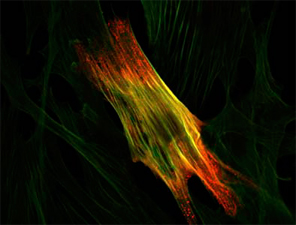IG Strategic Plan 2012-2017
The Canadian Institutes of Health Research (CIHR) is the Government of Canada's health research investment agency. CIHR's mission is to create new scientific knowledge and to enable its translation into improved health, more effective health services and products, and a strengthened Canadian health care system. Composed of 13 Institutes, CIHR provides leadership and support to more than 14,100 health researchers and trainees across Canada.
The CIHR Institute of Genetics supports research on the human and model genomes and on all aspects of genetics, basic biochemistry and cell biology related to health and disease, including the translation of knowledge into health policy and practice, and the societal implications of genetic discoveries.
Canadian Institutes of Health Research
160 Elgin Street, 9th Floor
Ottawa, Ontario K1A 0W9
Canada
Canadian Institute of Health Research
CIHR Institute of Genetics
McGill University
3649 Promenade Sir William Osler, Room 279
Montreal, QC H3G 0B1
Canada
stephanie.robertson@cihr-irsc.gc.ca
Available on the Web in PDF and HTML formats
© Her Majesty the Queen in Right of Canada (2012)
Cat. No. MR4–17/2012E–PDF
ISBN 978–1–100–21458–0
Table of contents
- Message from the Scientific Director
- Our Organization
- Our Current Context
- Our Five Year Plan
- Strengthening the IG Research Community
- Continued Support for Fundamental Research
- Facilitating the Creation of and Access to, Research Platforms and Enablers
- Strengthening Research Networks Nationally and Internationally
- Addressing Health and Health Systems Priorities
- Computational and Systems Biology
- From Models and Mechanisms to Therapies
- Health Services, Policy & Ethical, Legal and Social Issues Research
- Fostering Innovation, Commercialization and Translation Through Partnerships
- Going Forward
Message from the Scientific Director

Photo of Dr. Paul Lasko, Scientific Director
The Institute of Genetics (IG) Strategic Plan (2012–17) is a framework that will be used to guide our funding, community building and knowledge translation activities for the next five years. As in the past, IG is firmly committed to supporting the basic biomedical research community. Since the inception of the Institute, IG has served as the primary Institute that advocates for fundamental research and we look forward to continuing to serve the Canadian basic research community in this capacity. IG will do its utmost to ensure that the present strengths and future potential of the fundamental research community will be well positioned to benefit from the proposed reforms to the open operating grant program and to its peer review processes.
IG's pivotal role in two CIHR Signature Initiatives, Personalized Medicine and Epigenetics, will be central to its strategic activities over the next five years. To this end, IG will play a leading role in the development of a national strategy for the field of computational biology with our federal partners such as Genome Canada and with other stakeholders. As DNA sequencing becomes inexpensive, huge amounts of genetic data are being generated. Advances in the field of computational biology are thus essential, and currently rate–limiting, in the quest to harness the power of genomics to produce healthcare improvements for the benefit of Canadians. For this reason, computational biology has been flagged as a priority area within both the CIHR Personalized Medicine and Epigenetics Signature Initiatives, and other pan–CIHR strategies, such as data harmonization.
IG interacts with many outstanding fundamental researchers, but only some of these individuals interact with clinical researchers and with researchers oriented toward drug discovery. Fostering more of such relationships is a core activity associated with our second research priority "From Models and Mechanisms to Therapies". Working together, we improve the likelihood of identifying and validating novel drug targets and developing novel therapeutics with real potential. This will help deliver results from the CIHR signature initiatives referenced above. IG is particularly interested in the area of rare diseases. Most such diseases are genetic in nature, they are not core to the mandate of any other Institute, and technological advances make it a uniquely opportune time for research in this area.
Our third research priority demonstrates our strong commitment to Knowledge Translation (KT) and to research concerning ethics, health service delivery, and health policy issues that result from advances in genetics. Issues surrounding data privacy are coming to the forefront as genetic and genomic testing become commonplace, and genetic research becomes more highly collaborative. As we deliver on the CIHR Personalized Medicine Signature Initiative, the genetics/genomics health services, health policy, ethical, legal and social issues research community will play a critical role in the development of an evidence–base on how to assess, and where appropriate, integrate innovative diagnostics into health policy and practice.
As we proceed with this plan, we look forward to strengthening our relationships with national and international partners through our involvement with the International Rare Diseases Research Consortium (IRDiRC), the International Epigenome Research Consortium (IHEC), and potentially other international initiatives. We intend to complement this by more aggressively exploring ways to work with industry, focusing on how to partner effectively in an open access space to accelerate drug discovery and translate basic research advances into improved health care. It is only through bringing together the research communities embraced by the broad IG mandate with a diverse set of partners that we can successfully deliver on our ambitious strategic plan.
Our Organization
CIHR's mandate is to excel, according to internationally accepted standards of scientific excellence, in the creation of new knowledge and its translation into improved health for Canadians, more effective health services and products, and a strengthened Canadian health care system. CIHR is Canada's premier federal agency for health research. CIHR supports world–class health research to increase knowledge and to ultimately improve the health of Canadians.
In October 2009, CIHR launched its second Strategic Plan (2009–2014), Health Research Roadmap: Creating innovative research for better health and health care, that lays out CIHR's commitment to pursue the following strategic directions:
- invest in world class excellence
- address health and health system research priorities
- accelerate the capture of health and economic benefits of health research
- achieve organizational excellence, foster ethics and demonstrate impact
IG is one of CIHR's thirteen virtual Institutes. Each Institute is headed by a Scientific Director who receives guidance and advice from its Institute Advisory Board (IAB). IABs are made up of national and international representatives of the public, private, and non–profit sectors, including the research community and health practitioners. The Institutes are formally accountable to both the President and Governing Council of the CIHR, and through the Minister of Health to Parliament.
The work of the Institutes embraces the four themes of health research: biomedical; clinical; research respecting health systems and services; and social, cultural and environmental factors that affect the health of populations. A major challenge for the Institutes is to forge relationships across disciplines to stimulate integrative, multifaceted research agendas that respond to society's health priorities while adhering to the highest ethical standards. Accelerating the use of health research findings for the benefit of Canadians is another of CIHR's major challenges. Innovative KT strategies are the key to fostering the change in behavior, systems and policy required, when research is ready to translate into action.
To help address these challenges, IG established Priority & Planning (P&P) Committees as a mechanism through which members of the extended research community and key stakeholders can advise the Scientific Director and the IAB on strategic initiatives that should be undertaken by the Institute. The P&P Committees foster the development of their research communities; provide a forum for the identification of critical issues and opportunities; and facilitate input from, and dialogue with, their research communities and the users of their research.
Our Current Context
IG considers as an important part of its role to serve as the primary Institute that advocates for fundamental research using non-human and cell culture models that is aimed at gaining basic insights into biological processes of relevance to human health. It is self-evident that effective translation of advances in health research into effective treatments and improved health for Canadians requires a well-funded and vibrant com- munity of basic researchers and their trainees to produce new insights into cell function and biology that can then be translated. In addition, IG has also demonstrated a strong commitment to KT and to research concerning ethical and health-service delivery issues that resulted from the genetics revolution over the past decade. Overall, IG strives to:
- strengthen our broad community of biomedical researchers conducting fundamental discovery research
- bring together strong research communities to work in new ways not possible without cross-collaboration
- encourage Canadian partnerships in international health-related research efforts, and Canadian research leadership on an international scale
- foster the development of a community that will facilitate knowledge transfer of genetic and biochemical discoveries

Science & Science Policy Trends
The plummeting cost of nucleic acid sequencing and the more widespread availability of sequencing technologies have revolutionized genetics, making it possible to generate enormous amounts of data in a short period of time and at relatively low cost. These developments have quickened the pace of an already existing trend in genetics research toward larger collaborations. It is far more unusual today than 20 years ago for genetics papers in top international journals to have only two or three authors and to emerge entirely from a single research group. In its programs IG must recognize changing times and do its utmost to ensure that Canadian researchers can continue to excel in the present and future context.
To this end, IG has directed more of its strategic resources toward funding collaborative teams, from Emerging Teams comprised of usually three investigators to the national Finding of Rare Disease Genes in Canada (FORGE) consortium that encompasses much of the clinical genetics work on rare diseases that is underway in Canada. Partnerships with Genome Canada in rare diseases and personalized medicine have leveraged IG resources and ensured that the IG research community in these areas is fully supported by the genomic platforms it requires to be internationally competitive. IG has also been proactive in fostering Canadian leadership in international research consortia in relevant areas. For example, its Scientific Director serves actively on the Executive Committees of both IHEC and IRDiRC, and IG's support for research in these areas has been instrumental in enabling Canada to join these organizations as a full partner.
Canada is poised for international leadership thanks to our strengths in model organism and gene discovery research.
In the next few years it will be important for IG to continue developing links between those involved in human disease gene discovery with researchers who study gene function using model organisms. The interaction between these research communities is important to understand the roles of the disease genes in biology, which can aid greatly in the development of therapeutics, as validation is a critical step in the drug-discovery process. Canada is well positioned to make significant international contributions by leveraging our Canadian strengths in gene discovery and model systems.
IG hopes to expand its international activities into other areas relevant to its mandate as opportunities arise and as its resources permit. One important challenge that remains to be addressed in order to achieve a more highly collaborative research environment concerns data harmonization, so that patient data, including but not limited to that derived from large-scale sequencing, can be more easily shared among researchers in different provinces, and even among researchers in different countries. Improving data harmonization, which in IG's view is essential, involves substantial technological issues and also the resolution of numerous legal and ethical questions related to privacy and similar concerns. IG is committed to partnering with other stakeholders to achieve progress in this critical area.
Another barrier to improved collaboration, especially with the private sector, is the premature protection of intellectual property. IG, through its Scientific Director, is an active participant in discussions that are taking place internationally among scientists working in academic and industrial settings, public and private research funders, regulatory agencies, and voluntary health organizations to develop mutually beneficial approaches to move more early-stage discovery research into the pre-competitive space. This will allow data and information to be shared more openly at the early stages of target identification in order to focus a critical mass of researchers and thus accelerate the pace of discovery.
To capitalize on the opportunities underscoring these trends, IG and the research community it represents will face challenges that will need to be addressed over the next five years, including:
- maintaining and improving the present positive trends in the quantity and quality of Canadian research relevant to the IG mandate, in the probable context of a challenging overall funding environment and at a time when research in the area is becoming increasingly reliant on large-scale approaches that require complex collaborations and substantial investment;
- striving to enable Canadian researchers with leading roles in international projects to command sufficient resources to carry out those roles;
- ensuring that our successes in fundamental research are efficiently and effectively translated to the patient, while taking due caution not to encourage overly accelerated translation, which can result in misinformation and actual harm to patients and their caregivers;
- ensuring that funding for large-scale experimentation involving high-throughput technologies is available as support from numerous sources, often based in multiple countries, is normally required; and
- fostering a robust discussion of ethical and policy questions concerning, among other issues, the use and misuse of genetic testing and genomic information in the particular context of the Canadian health care system.
In the spirit of CIHR's strategic plan, and in the context of the ever-increasing trend toward large-scale projects in relevant research areas, IG is interested in supporting new, more comprehensive programs aimed at further strengthening biomedical research in Canada as one of its strategies. To do this, IG must continue to partner not only within CIHR and with its dedicated voluntary health organization community, but also with other national and international partners who share IG's interest in supporting research teams in which Canadians are prominent players.

2011 CIHR International Review Observations
In its first 10 years, IG has established itself as CIHR's chief advocate for fundamental research in genetics, cell biology and biochemistry, and its activities have been associated with increased Canadian research productivity in all these areas. The Institute has also acted effectively with regards to its mandate in the other three CIHR themes. It has fostered successful new programs to advance clinical and population-based research, and partnered with other Institutes toward progress in health services research and with regards to ethical, legal and social issues.
The 2010 CIHR International Review was largely supportive of IG. In particular, the IG Expert Review Team's Report included a strong statement that IG is regarded as a flagship Institute for CIHR as a result of its:
- clear vision, strong leadership and ability to lead strategic directions of CIHR as a whole
- success in engaging partners and stakeholders
- important capacity building efforts which have moved health research in the field of genetics into an internationally competitive position
Since CIHR's inception IG has advocated for investment in fundamental research in genetics, cell biology and biochemistry, and Canadian research impact has increased in all these areas.
Going forward, the IG Expert Review Report identified the following specific areas that require attention and greater focus:
- Computational biology and systems biology: Computational and systems biology were perceived as having not been sufficiently integrated within the priorities of IG. It was recommended that IG play a leading role in the development a coordinated national strategy targeting computational biology and systems biology, in partnership with other units of CIHR and with funding agencies such as Genome Canada and Natural Sciences and Engineering Research Council (NSERC).
- International efforts: International joint programming and cooperation will be a prominent attribute of competitive research as the research landscape becomes increasingly global. IG and CIHR were strongly encouraged to proactively support a further engagement of Canada with the international scientific community.
- Health Care Policies and Regulatory Issues: Healthcare will become increasingly genetically informed. IG was encouraged to actively support informed changes to health care policies related to genetics on the basis of scientific evidence.
- Commercialization: Rapid developments in genomic and medical technology bring along new business and economic opportunities for Canada while also advancing the research enterprise. IG, as well as CIHR in its entirety, was encouraged to strengthen its efforts for efficient knowledge transfer and for cooperation with industrial partners, including the establishment of novel private-public partnerships.

CIHR Signature Initiatives – Implementing CIHR's Strategic Plan
Investment in health research requires careful consideration of where Canada can capitalize on areas of strength and excellence, energize identified priority areas, and build research capacity in new fields of health research to have the biggest impact. By concentrating our resources on priority areas through strategic initiatives, we help generate discoveries that translate into better health products, health services and health policies.
Through a highly consultative process involving internal and external stakeholders, several CIHR Signature Initiatives have been developed as primary foci for strategic investments that are designed to deliver on CIHR's Strategic Plan (2009-2014) and innovative strategies, such as the CIHR Strategy on Patient-Oriented Research (SPOR). IG is a co-lead on two of the first CIHR Signature Initiatives to be launched:
- Canadian Epigenetics, Environment and Health Research Consortium (CEEHRC) led by the CIHR Institute of Neurosciences, Mental Health and Addiction (INMHA), IG and the CIHR Institute of Cancer Research (ICR): This initiative will ensure that Canada plays a leadership role in the field of epigenetics, which has the potential to transform our ability to 'read' and subsequently manipulate functional states of a genome within specific cell types.
The CIHR Personalized Medicine Signature Initiative includes the rare disease research community as its efforts to effectively develop therapies for small patient populations are informative for stratification strategies.
- Personalized Medicine led by IG, ICR and the CIHR Institute for Health Services and Policy Research (IHSPR): This major initiative was made possible through a critical partnership with Genome Canada and further support from the Cancer Stem Cell Consortium. It aims to capitalize on Canadian health researchers' strengths in identifying disease–relatedgenes and biomarkers and in translational research in order to integrate evidence-based medicine and precision diagnostics into clinical practice, through patient stratification approaches. This innovative program is also designed to support research projects focused on the genomics and its ethical, environmental, economic, legal and social aspects. These include studies relying on methods such as health technology assessment, comparative effectiveness or health outcome assessments related to the integration of genomics–based practices or technologies to inform decision–making by governments or other stakeholders.
Unique to the CIHR Personalized Medicine Signature Initiative are close links between the rare disease community, with its experience in developing therapies for small populations, and the cancer research community, who are developing molecular methods to move away from 'one–size–fits–all' treatments and toward more precise and targeted approaches.
Synergies exist between all the CIHR Signature Initiatives that represent areas of joint collaboration, such as Personalized Medicine and Community–Based Primary Health Care. In addition, some CIHR Signature Initiatives are at an earlier stage of development where the IG can see itself being a key contributor going forward, such as Pathways to Health Equity for Aboriginal Peoples.
Our Five Year Plan
This plan outlines three strategic objectives for the next five years that will guide future activities of the Institute, including funding opportunities and knowledge translation initiatives.
- Strengthening the IG Research Community
- Addressing Health & Health System Priorities
- Fostering Innovation, Commercialization & Translation Through Partnerships

A confocal image of part of an early Drosophila embryo. Nuclei are labelled in blue with a fluorescent DNA stain, while primordial germ cells are labelled in green by immunostaining for Vasa protein. Picture provided by Hong Han (McGill University).
Strengthening the IG Research Community
Continued support for fundamental research in biological and biomedical science that is essential for Canadian competitiveness
IG considers as a core component of its mandate to serve as the home Institute for biomedical researchers doing fundamental research and who rely solely on open grants competitions for their funding. Following research community consultation, CIHR is now engaged in a comprehensive effort to reform its peer review procedures and suite of open grants programs in order to make the process more efficient for applicants and reviewers. IG will continue to actively participate in the evaluation and development of the proposed reforms and to evaluate their potential impact on its core research communities. As proposed changes are implemented, a process that may extend through much of the timeframe covered by this strategic plan, IG will participate actively in monitoring and evaluating their effects on behalf of its research community.
Facilitating the creation of and access to research platforms and enablers
Research platforms and enablers, which provide services, information, experimental materials, technologies, tools and/or instrumentation that can enhance collaboration and facilitate research, are at the interface of the mandates of several Canadian agencies, including CIHR, Canadian Foundation for Innovation, NSERC and Genome Canada. These efforts can contribute in important ways towards positioning Canada as an international research leader. This area of convergence between health research federal funders represents an opportunity to work in a coordinated manner to support large– science initiatives. Conversely, without such coordination important initiatives can fail to find support in that each individual organization can be reluctant to take on full responsibility. IG is committed to playing a proactive role in coordinating funders to develop transparent and sustainable plans to assess and fund requests for large–scale investments in areas relevant to IG researchers.
Strengthening research networks nationally and internationally
Health research is an endeavour that transcends national boundaries, and bibliometric analysis suggests that research articles co–authored by international teams of investigators have a higher average impact than those that originate from a single country. Genetics research in particular is becoming an endeavour that increasingly requires collaboration among different research groups to achieve success. In this context, issues of data access and harmonization, interoperability and other technological, legal and ethical barriers to collaboration will grow in importance and complexity. The development of a coordinated national strategy, and a corresponding implementation plan, will be required to address these challenges. IG is committed to efforts to achieve this outcome.

Addressing Health and Health Systems Priorities
As part of our commitment to advancing two CIHR Signature Initiatives, IG established an intentionally broad set of strategic research priorities that will collectively advance these initiatives. In addition, these research priorities will serve as a mechanism to target our investments in support of research excellence and knowledge translation in areas of critical importance that will maximize resources, impact, and benefit for Canadians.
- Computational and Systems Biology
- From Models and Mechanisms to Therapies
- Health Services, Policy & Ethical, Legal and Social Issues Research
Computational and Systems Biology
There has arguably never been a time in the history of science and its many sub–disciplines, when the knowledge base is expanding as rapidly as it is today in the bio–molecular life sciences. Large–scale approaches fueled by technological innovations are driving the identification of the molecules and their interactions that define cellular pathways, tissues and organisms. The integration of this knowledge to provide a systems–level understanding of biology will generate new conceptual insights, spur technology development, and have profound impacts on predictive and preventive medicine.
Current genome sequencing and systems biology efforts are creating biomedical data sets of unprecedented size and complexity, such that advanced computational tools are required for their analysis. While the fundamental data holds enormous potential for addressing medical, environmental and social issues, extracting value from this vast repertoire of information will critically depend upon the ability to analyze and extract knowledge from the basic data.
Canada must expand its efforts in computational biology and bioinformatics, and strive to harmonize various databases, as health research, and healthcare, become ever more data–intensive.
Computational Biology and Bioinformatics are disciplines that span the realm of both biological and computer sciences, and are directed to developing innovative approaches to the analysis of complex genomics and systems biology data sets, leading to new knowledge and applications that will benefit the Canadian healthcare system and life sciences sector. This is of crucial strategic importance if Canada is to compete in the global arena to develop novel translational research applications in medicine. The national competitive advantage will depend upon the development and deployment of a pan–national, multi–agency and coordinated strategy directed to enhancing Canada's capacity and innovation potential in the computational life sciences.
Canada possesses an internationally recognized capability in genomics and systems biology. Past investments have provided cutting–edge technological capacity and built considerable intellectual capital yet there persists a shortage of highly qualified personnel with the necessary cross–disciplinary training and broad–based skill set to fully capture the benefits of systems biology–related research. A substantial, coordinated long–term investment is required to remain internationally competitive and yield the benefits of continued advancement in scientific knowledge and technological capacity.
What must be done?
- Canada must coordinate and expand its effort in the area of computational biology and bioinformatics to build technological capacity and encourage innovation
- a concerted and long–term program for training a new generation of innovative and multidisciplinary computational biologists is required if Canada's future competitiveness is to be realized
- the nation must move to coordinate the efforts of the several public life science support agencies and stakeholders toward the goal of a complementary and synergistic national strategy in bioinformatics and systems biology
From Models and Mechanisms to Therapies
Nature reuses the same building blocks to construct organisms as different as yeasts, worms, flies, fish, mice, and humans. This allows us to find out what our genes do through an analysis of similar genes in "model organisms" that can be readily manipulated in the laboratory. The genome sequencing projects of the 1990s directly demonstrated the striking extent to which all organisms are built by the same genes and highlighted the enormous value of model experimental organisms for the study of evolutionarily conserved gene function. Few, if any, processes at the gene level are known to be unique to humans. Indeed, key aspects of most human disorders can be modeled in experimentally tractable organisms through the analysis of orthologous genes and pathways using the genetic, biochemical and cell biological toolboxes that have been developed for each model organism.
Over the past four decades, model organisms have revealed novel biological processes that later were reported to function in humans. The budding yeast, Saccharomyces cerevisiae, was the key organism for elucidating the cell division cycle, a process central to the development of cancer. Of the 12 genes mutated in the peroxisome biogenesis disorders, 11 were first identified as homologues complementing peroxisome assembly mutants in yeast. The worm Caenorhabditis elegans, first revealed the mechanisms of apoptosis, which is essential for organismal development, normal physiology, and disease development and progression when it goes awry. The fruit fly Drosophila has illuminated the activity of brain neurons, the genetics of addiction, the development and progression of cancer, and the first clues to innate immunity. And the mouse, like all mammals, is genetically so close to humans that segments of its genome are sometimes hard to discern from ours. Each model organism has its own advantages and disadvantages for the study of a particular process – for instance Drosophila doesn't have bones, but it has a heart! Clearly, the aggregate of model organisms is much more powerful than any single model because of the complementarity of their biology and experimental tools. It is becoming increasingly feasible to shuttle between species in studying the mechanisms of conserved biological processes and the phenotypes associated with specific gene mutations associated with human disease.
We are at the brink of an unprecedented era of mutation discovery in humans. Next generation sequencing has significantly accelerated the pace of discovery of human genetic variation and its association with human disease. For example, determination and comparison of the entire genome sequence from as few as four patients suffering from an "orphan disease" can reveal the single gene, mutated in each of the four genomes, that is the major genetic determinant of disease. Who could have predicted, even four years ago, when Jim Watson's personal genome sequence was published in Nature using prior, much more expensive technology, that a human genome would be obtainable for less than $10,000 today? We have taken a quantum leap from the days of positional cloning in the late 1980s, when the first Mendelian disease genes were slowly and at great expense being discovered, only to find that the gene's function was largely unknown.
How do we translate genomic information to advancements in diagnosing, preventing, and treating human disease? The answers are in the elucidation of gene function and in the understanding of how biological mechanisms are affected by specific mutations. Here is where model organism genetics, coupled with dynamic interdisciplinary dialogue and collaboration between medical scientists and basic researchers, will illuminate and be critical for decades to come.
Health Services, Policy & Ethical, Legal and Social Issues Research
Developments in genetic science and technology hold important implications for understanding and intervening in human health, and thus raise challenging and broad–ranging questions about practice and policy. For genetics and genomics research, these developments raise questions about research conduct and the policies required to govern the research enterprise. For health care services and systems, these developments raise challenging questions about the translation of new technologies into clinical care to improve health outcomes and support sustainable health care systems. Finally, these developments raise ethical, legal and social issues (ELSI) for society as a whole, regarding the role of genetics in health and disease, health care and health research priorities, and individual and collective responsibilities for health and health care.
Rapid developments in genetics and genomics raise profound implications for human health interventions, which in turn raises complex ethical and social questions about practice and policy.
Canada has developed research excellence and achieved international recognition in ELSI and must sustain its support for these areas of research in order to maintain its leadership. Moreover, to accelerate knowledge translation, research is needed that addresses the Canadian healthcare system and is attentiveness to Canada's cultural diversity and the continuing challenges of health inequities. Finally, Canadian researchers must continue to engage with humanities scholarship and social science research across a wide array of topical areas, to ensure the continued excellence and relevance of research that takes as its focus ongoing developments in genetics and genomics. Health services, policy and ELSI research in genetics is multi–disciplinary and wide–ranging. A representative sample of topics includes:
- research in health technology assessment and priority setting, to support decision makers in making genetic technologies available to patients in a cost effective way, while accounting for complex social, ethical and organizational factors
- health services research, to explore ways to translate new knowledge to the clinic for the benefit of Canadians, including through health professional education and engagement, and the organization and evaluation of service delivery arrangements
- research that explores ways to better engage diverse publics, in understanding and helping to direct genetics research and the organization and delivery of genetic health services
- exploration of research ethics challenges, including the governance of biobanks and data sharing, and the communication of research results
- research that investigates social concerns and challenges, such as the direct to consumer delivery of genetic tests, issues arising in research and service delivery for individuals with rare (or 'orphan' diseases), and continued concerns about genetic discrimination and stigmatization

Fostering Innovation, Commercialization and Translation Through Partnerships
IG recognizes that operating in an isolated silo and failing to team with other organizations with complementary interests will likely result in outcomes of limited reach and impact. Building partnerships is thus essential for IG to maximize its impact and best achieve its goals, especially in a resource constrained context. In its recent initiatives IG has leveraged its own funding by as much as 10–fold by recruiting other units of CIHR and external partners, most prominently Genome Canada. IG will continue to partner in this way in order to maximize its impact and broaden the appeal of its activities.
Partnerships are also essential to knowledge translation. Developing partnerships with industry has a positive impact on Canada's ability to translate its strength in basic research to improvements in health care. IG is committed to working with industry and to fostering deeper partnerships with it, with a particular emphasis on public–private partnerships that extend the bounds of open–access research as far as feasible. Success in this area would result in accelerated drug discovery at reduced cost, because redundant proprietary work developed in parallel in multiple organizations would be avoided. This approach would also encourage the release of negative data that is now proprietary, thereby raising awareness of adverse effects of drugs early in their development, ultimately reducing potential harm to patients who today participate in needless redundant clinical trials. IG is well positioned to lead the required policy discussions about commercialization to help move forward a legal and economic framework for intellectual property that would encourage and incentivize pre–competitive collaboration rather than discouraging it.
IG believes it to be essential to involve knowledge users in design, implementation, and evaluation of its strategic initiatives.
It is impossible to develop new therapeutics without the involvement of industry, and it is impossible to translate research advances into healthcare practices without the involvement of provincial and national health authorities, regulatory bodies, and voluntary health organizations. IG considers it essential to involve knowledge users at all stages of its development of strategic initiatives, and to continue to work together to ensure more effective uptake of the results its researchers obtain.
Going Forward
With the advent of inexpensive genomic sequencing, the next five years will be revolutionary in genetics. IG is committed to ensuring that Canada is a world leader both in producing new developments in genetics research and in the application of genetics to the benefit of humankind. We are looking forward to working closely with our research community and partners to successfully deliver on this ambitious strategic plan.
- Date modified: